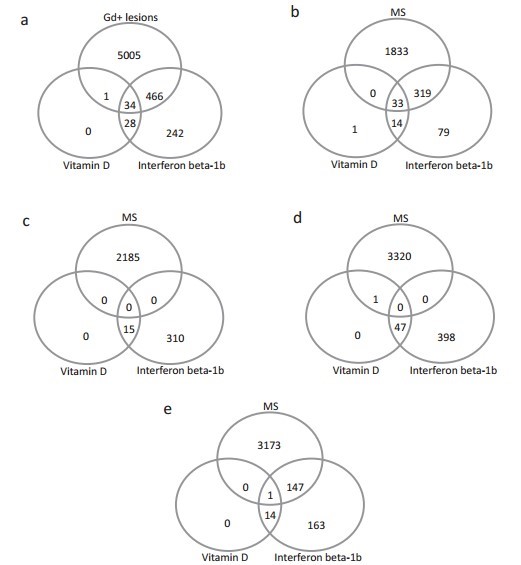Multiple Sclerosis, gene expression, and vitamin D: Venn diagrams

Molecular mechanism underlying the impact of vitamin D on disease activity of MS
Annals of Clinical and Translational Neurology, Article first published online: 22 AUG 2014
Kassandra L. Munger 1,†,*, Karl Köchert 2,†, Kelly C. Simon 1, Ludwig Kappos 3, Chris H. Polman 4, Mark S. Freedman 5, Hans P. Hartung 6, David H. Miller 7, Xavier Montalbán 8, Gilles Edan9, Frederik Barkhof4, Dirk Pleimes2, Rupert Sandbrink2,6, Alberto Ascherio1 and Christoph Pohl2,10
Objective
Some previous studies suggest modest to strong effects of 25-hydroxyvitamin D (25(OH)D) on multiple sclerosis (MS) activity. The objective of this study was to explore the mechanistic rationale that may explain potential clinical effects of 25(OH)D.
Methods
This study measured serum 25(OH)D levels and global gene expression profiles over a course of up to 2 years in patients starting treatment with interferon beta-1b (IFNB-1b) after a clinically isolated syndrome. MS disease activity was assessed by the number of gadolinium-enhancing lesions present on repeated magnetic resonance imaging (MRIs).
Results
The number of gadolinium-enhancing lesions was highly significantly associated with 25(OH)D levels. Conducting various systems-level analyses on the molecular level, multiple lines of evidence indicated that 25(OH)D regulates expression dynamics of a large gene–gene interaction system which primarily regulates immune modulatory processes modulating MS activity. The vitamin D response element was significantly enriched in this system, indicating a direct regulation of this gene interaction network through the vitamin D receptor. With increasing 25(OH)D levels, resulting regulation of this system was associated with a decrease in MS activity. Within the complex network of genes that are regulated by 25(OH)D, well-described targets of IFNB-1b and a regulator of sphingosine-1-phosphate bioavailability were found. The 25(OH)D effects on MS activity were additively enhanced by IFNB-1b.
Interpretation
Here, we provide mechanistic evidence that an unbalanced 25(OH)D gene expression system may affect MS activity. Our findings support a potential benefit of monitoring and managing vitamin D levels (e.g., through supplementation) in early MS patients treated with IFN-beta-1b.
📄 Download the PDF from VitaminDWiki.
See also VitaminDWiki
98 pcnt of genes that Vitamin D activates to reduce MS are also activated by Interferon -May 2013
3X more vitamin D from the sun if take MS drug Interferon-β – July 2012
Review of clinical trials for Multiple Sclerosis with Vitamin D intervention – 2013
Vitamin D reduces multiple sclerosis relapses, but not with interferon treatment – June 2012
The articles in both of the categories MS and Genetics are:
{category}
The articles in both of the categories MS and Vitamin D Receptor are:
{category}
The articles in both of the categories MS and Vitamin D Binding Protein:
{category}
